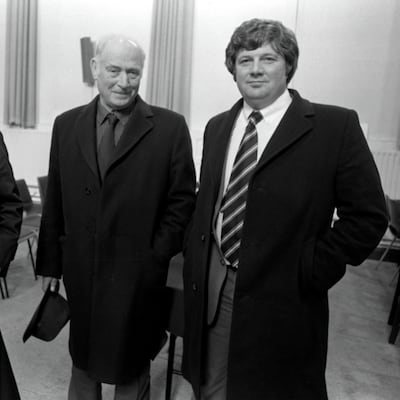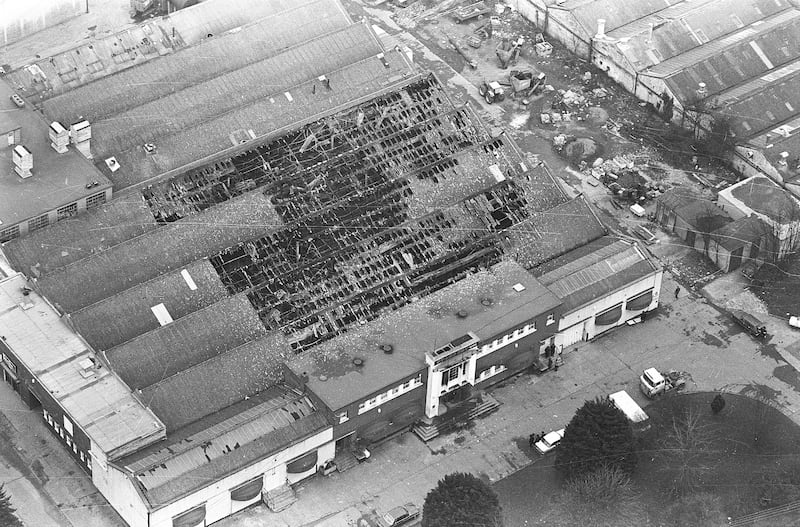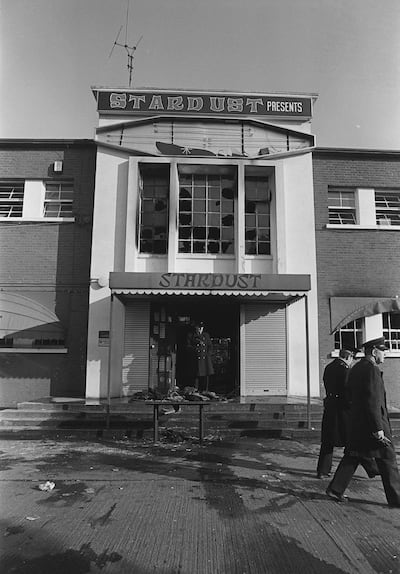The Stardust inquests into the deaths of 48 young people in a fire at the north Dublin nightclub in 1981 closed on Friday for a six-week break with what is likely to be some of the most significant evidence of the hearings.
Leo Doyle, deputy head doorman at the venue at the time of the disaster, who was then 33, gave evidence over four days – longer than any witness so far.
Just before lunchtime on Friday, after days of contradictory evidence, he said he believed the emergency exits “were locked” on the night. He also agreed a “scam” in place among some doormen, to allow patrons in via side doors without paying the full cover-charge, was a central reason manager Eamon Butterly had ordered all exits to be locked during discos.
[ Stardust inquests: Senior doorman told his junior to leave emergency exits lockedOpens in new window ]
The 48 inquests are being held under the direction of Dublin coroner Myra Cullinane in the Pillar Room on the grounds of the Rotunda Hospital (the coroner’s court on Store Street being too small to accommodate the large number of legal representatives and family members).
They are inquiring into the deaths of the 48, aged 16-27, in the Artane ballroom in the early hours of February 14th, 1981, following a 2019 direction by then attorney general Séamus Woulfe that they be opened.
Though inquests were already held, over five days in 1982, these were regarded as perfunctory by families – lasting about 15 minutes each and returning the medical causes of death only. In the 42 intervening years the families have contended that the full truth of how the fire started, why it spread so rapidly and whether more should have been done to protect and save the lives lost has remained hidden.
“The scale and horror of the tragedy was such that was and remains the greatest such disaster to have occurred in the history of the State,” said Woulfe in his letter to Dr Cullinane in December 2019.
In those 1982 inquests, he noted, “there was no reference to the surrounding circumstances ... and it does not appear that questions as to the cause or causes of the fire were canvassed to a sufficient degree, if indeed at all, at the original inquests”.
In a disaster of “such magnitude” not only were the families entitled “to the public revelation of the facts” but so too “the community as a whole should be satisfied “sufficient inquiry” is held “to maximise the chances that the truth should emerge”, said Woulfe. This would “serve the further public interest grounds ... of allaying rumour and suspicion”.
Among key facts established is that none of those working at Stardust had formal fire-safety or emergency training. Planning and fire-safety regulations appear to have been erratically adhered to and enforced
Dr Cullinane and her legal team have organised more than 300 witnesses into four modules. The first, almost complete, is of about 80 witnesses who were either involved in the refurbishment of the former jam factory in 1978, in its management and oversight, or worked there on the night.
Next the 14-person jury will hear from patrons on the night and members of the public who saw the fire, then emergency services, and finally from expert witnesses. Legal teams expect the pace to pick up in autumn, and for direct evidence to be complete by Christmas.

Among key facts established is that none of those working at Stardust had formal fire-safety or emergency training. Planning and fire-safety regulations appear to have been erratically adhered to and enforced. Stardust owner Patrick Butterly – now dead – took little interest in these during refurbishment of the former jam factory into a nightclub in 1978, leaving concerns about these to his son, Eamon.
On Friday, February 13th, 1981, about 800 young people, most from the surrounding working-class communities of Kilmore and Coolock, paid £3 each to attend a disco-dancing competition sponsored by record company K-Tel. The competition was just over when a small fire was first seen, at about 1.40am, on the back of a seat in a partitioned-off section of tiered seating, known as the west alcove.
Testimony has been harrowing to hear and, for many witnesses giving evidence, to relive.
Colm O’Brien, aged 20 and one of the five DJs on the night, by video-link from Boston told the inquests he thought the fire would be controlled. “As the fire got bigger I could see some of the people beginning to panic. I then made an announcement over the microphone.” He told people not to panic and continued playing music.
People in front of the stage panicked and ran on to the stage ... Girls were grabbing, asking for the way out
— Colm O'Brien, a 20-year-old DJ on the night
About 30 seconds later, however, as smoke billowed across the ceiling towards the stage, he made a further announcement, urging people to move quietly to the exits. “About a minute after I first saw the fire, the entire area which was partitioned off was ablaze. I was still on the stage ... People in front of the stage panicked and ran on to the stage ... Girls were grabbing, asking for the way out.”
Several witnesses described, once they got out, hearing screams from inside the toilets by the main entrance, the windows of which had had metal shutters and bars welded to them six weeks earlier.
Among the 24 dead witnesses whose 1981 Garda statement was read into the record was doorman Patrick J Murphy. He got out and was “amazed to see the fire had spread so rapidly across the ballroom. The place was engulfed in flames and I could see a couple of feet into the building,” he said.
This person was completely on fire. When she fell, I and two others ... got down on our bellies, crawled in and pulled her out. When we got her out, she appeared to be dead
— Doorman Patrick J Murphy
“As I looked in I saw a young girl run towards the door through the flames and she fell about four feet inside the door. This person was completely on fire. When she fell, I and two others ... got down on our bellies, crawled in and pulled her out. When we got her out, she appeared to be dead.
“I saw another girl run towards the door but she fell further inside and was burned. I could not get in because the flames were blowing off the wall and coming from the roof and the heat was intense,” Murphy said.
Dr Cullinane said she was “aware” that “certain content” had been “very distressing for families present and watching remotely ... Sadly it will be a factor in these inquests that there will be distressing content at times.”

There has been some evidence suggesting the fire was seen from outside the Stardust earlier than 1.40am, suggesting it may have started in the roof space, where wiring and a central heating motor were located close to stores of plastics, cooking oil and cleaning products.
Maeve Naughton, a waitress on the night, said while she first smelled smoke shortly after 1.40am and was aware of fire after 1.50am, her brother, who lived in the nearby Beauvale area, could see flames through the roof closer to 1am, she said.
“It’s about from here to say, less than Clerys [about 500m]. He saw the flames at 1 o’clock. He still says that. He saw the roof on fire at 1 o’clock.”
Among the key questions for the families is: where did the fire start? Could it have been in the roof space rather than in the venue?
Of the six emergency exits, two were obstructed on the night – one by a bottle-skip inside and another by a DJ’s van parked outside. Around one of these, known as exit five, 22 of the bodies of the dead were found, the inquests heard.
One of the six exits was the main entrance. Its shutters were likely to have been partially pulled down when the fire broke out. The remaining five almost certainly, at minimum, had chains and locks draped over the push-bars to make them appear locked, to stop people letting their friends in without paying. This was long-standing Stardust policy.
A further key question is: were any, or even all, of the exits fully locked on the night?
For the first hour or so we, yes, kept [emergency exits] locked, for to stop the people from coming in. It was just the policy. I didn’t make the policy. We only did what we were told to do
— Phelim Kinahan, head of security on the night
The inquests heard Stardust manager Eamon Butterly, had a growing “paranoia” about people getting without paying at the cashdesk. This peaked four weeks before the disaster and a new policy was introduced – that all exits would be kept locked until 12.30am or later, the inquests heard.
Phelim Kinahan, head of security on the night, confirmed: “For the first hour or so we, yes, kept [emergency exits] locked, for to stop the people from coming in.” They could all be kept locked as late as 12.40am, he added.
“It was just the policy. I didn’t make the policy. We only did what we were told to do ... ask Eamon Butterly,” he said.
On Friday Mr Doyle agreed he, with some other doormen, was involved in a “scam” in which “a good number of people” gained access to the venue as doormen let them, charging them less than the covercharge.
“Eamonn Butterly got to know about this – people getting in without paying at the cashdesk,” he said, “That is why the policy changed to lock all the doors?” he was asked. “Yes,” he said.
A third key question is: was there a “conspiracy” among some doormen to direct what gardaí and the Keane tribunal were told about emergency exits?
Doyle’s testimony this week, though often rambling and contradictory, suggested a concern among senior management about “managing” their narrative on the condition of the exits that night.

We heard all doormen and management were summoned to a meeting at the Stardust the morning after the fire, on the February 14th, 1981. They met Butterly’s solicitor there at 2pm, before giving Garda statements that afternoon.
While one doorman, Michael Kavanagh, then aged 20, gave media interviews and a Garda statement that he had unlocked the exits at about 9.30pm on February 13th, he told friends he had in fact been told by Doyle to leave them locked.
His friends reported this to gardaí on February 17th, the inquests heard, and on the 19th he amended his original statement to say he had left the doors locked. When gardaí “rounded up” all doormen on February 20th, Doyle told them it was in fact Kennan who had unlocked the doors. Kennan is dead.
Doyle remained unclear at the inquests whether he now believed Kavanagh or Kennan had unlocked the exits on the night of the fire, as Bernard Condon, senior counsel for the families of 10 of the dead repeatedly and robustly asserted neither of them had, and the emergency exits remained chained and locked as a small fire on a seat in the west alcove grew and engulfed the entire venue within minutes.
Kavanagh, a crucial witness, is scheduled to be the first to take the stand when the inquest resume on September 4th. Butterly is due to follow him on the 7th.

















